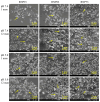Long-Term Stability and Osteogenic Activity of Recycled Polysulfone-Calcium Silicate Bone Implants In Vitro
- PMID: 39852587
- PMCID: PMC11765742
- DOI: 10.3390/jfb16010031
Long-Term Stability and Osteogenic Activity of Recycled Polysulfone-Calcium Silicate Bone Implants In Vitro
Abstract
Environmental protection issues have received widespread attention, making material recycling increasingly important. The upcycling of polysulfone (PSF) medical waste, recognized as a high-performance plastic with excellent mechanical properties, deserves promotion. While PSF is suitable for use as an orthopedic implant material, such as internal fixation, its osteogenesis capabilities must be enhanced. Mechanical stability, particularly over the long term, is a significant concern for bone implants in load-bearing applications. This study recycled PSF medical waste to create bone composites by incorporating osteogenic calcium silicate (CaSi) at three different contents: 10%, 20%, and 30%. We evaluated the phase, morphology, weight loss, and three-point bending strength of the PSF-based composites after they were soaked in dynamic simulated body fluid (SBF) at pH levels of 7.4 and 5.0 for up to 12 months. Human mesenchymal stem cells (hMSCs) were utilized to assess the osteogenic activity of these composites. Our findings revealed that, while the bending strength of PSF-based composites declined with prolonged exposure to SBF, the dissolution of CaSi particles led to a manageable weight loss of about 4% after 12 months, regardless of pH 7.4 or 5.0. Importantly, the incorporation of CaSi into the PSF matrix exhibited a positive effect on the attachment and proliferation of hMSCs. The levels of alkaline phosphatase (ALP) and calcium deposits directly correlated with the CaSi content, indicating superior osteogenic activity. Considering biostability and osteogenic ability, the 20% CaSi-PSF composite demonstrated promise as a candidate for load-bearing implant applications.
Keywords: biostability; bone implant; calcium silicate; osteogenesis; polysulfone.
Conflict of interest statement
The authors declare no conflicts of interest.
Figures











References
-
- Khaliha S., Tunioli F., Foti L., Bianchi A., Kovtun A., Marforio T.D., Zambianchi M., Bettini C., Briñas E., Vázquez E., et al. Upcycling of plastic membrane industrial scraps and reuse as sorbent for emerging contaminants in water. Environ. Sci. Water Res. Technol. 2024;10:1097–1107. doi: 10.1039/D3EW00900A. - DOI
Grants and funding
LinkOut - more resources
Full Text Sources

